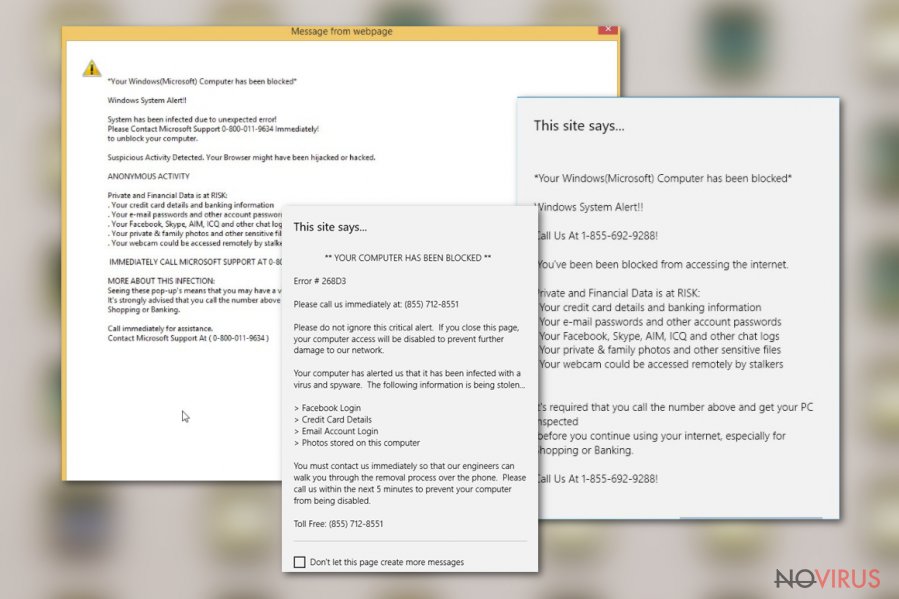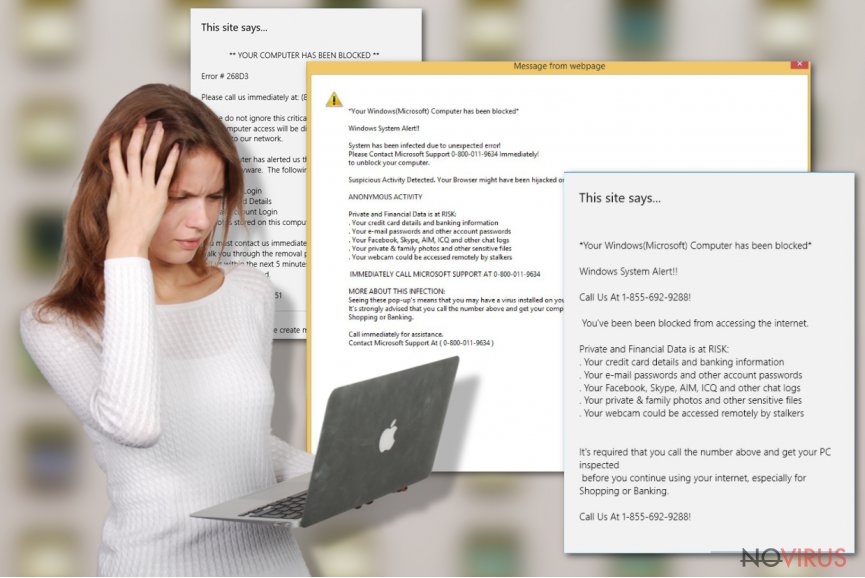Remove Your Windows (Microsoft) Computer has been blocked (Tech Support Scam) - Jun 2017 updated
Your Windows (Microsoft) Computer has been blocked Removal Guide
Description of Your Windows (Microsoft) Computer has been blocked tech support scam
Your Windows (Microsoft) Computer has been blocked warnings are an example of scareware
“Your Windows (Microsoft) Computer has been blocked” is a fake alert that might show up anytime when you are browsing the web. Users might end up on malicious site or receive a pop-up informing about infected computer and danger to the personal data. This notification informs that user’s email and social media details, photographies, and other sensitive information might be stolen. Apart from that, some shady people might be capable of accessing the webcam and watch what you are doing. Undoubtedly, all these threats are lies and cheap methods to make people call to 1-888-243-3533. The main purpose of Your Windows (Microsoft) Computer has been blocked scam is convince inexperienced computer users to dial the provided number. Keep in mind that dialing this number might be charged a lot, even if crooks say that it’s a toll-free line. What is more, scammers might be willing to sell you useless security programs or trick into installing malware. Cyber criminals are hiding under the legitimate name of the Microsoft Corporation. However, you should never forget that Microsoft does not have phone support service, and this alert is fake. Thus, you should scan the computer with FortectIntego and remove Your Windows (Microsoft) Computer has been blocked malware from the device.

There are numerous ways how Your Windows (Microsoft) Computer has been blocked tech support scam spreads and reaches the audience, and we will discuss them in the next chapter. However, it’s important to mention that websites that are responsible for spreading this scam usually are designed to look similarly to Microsoft’s official site. Thus, inexperienced computer users can be easily scared by Your Windows (Microsoft) Computer has been blocked virus. What is more, malware might prevent from closing the tab easily or open new tabs and display the same warning. In some cases, tech support scam sites play the audio file in order to cause bigger chaos and scare a person even more. Apart from disturbing browsing session with fake alters, malware might also cause other problems. For instance, your browser might crash frequently, computer’s performance might become sluggish, and you might notice an increased amount of online ads that might redirect to infected websites. There’s no doubt that you have to perform Your Windows (Microsoft) Computer has been blocked removal ASAP in order to avoid possible damage.
Scammers use multiple methods to reach people
One of the main ways how users encounter Your Windows (Microsoft) Computer has been blocked ads, pop-ups and redirects are adware infection. This type of potentially unwanted programs (PUP) usually arrives on the system in the software bundle. Thus, when installing freeware or shareware, you have to be careful and rely only on Advanced/Custom settings. If you see the list of pre-selected entries, you have to untick all these entries. In this way, you can avoid installation of undesired apps. However, if you are already suffering from Your Windows (Microsoft) Computer has been blocked virus, probably you have recently installed a program using Quick/Recommended settings. Bear in mind that such setups do not reveal about additional software and install all third-party components silently. Thus, in this way, adware program which is responsible for redirecting to the fake tech support site, entered the system. However, the adware infection is not always the problem. When browsing on high-risk websites (e.g. gaming, gambling, adult themed, etc.) or after clicking on a malicious ad, you might also be redirected to the site that gives a fake message from Microsoft. Thus, you should be careful online and do not trust each alert that pop-ups on the screen.
Getting rid of Your Windows (Microsoft) Computer has been blocked ads
Usually, these fake ads and redirects are triggered by an adware program. Thus, you have to investigate the system and remove Your Windows (Microsoft) Computer has been blocked virus with all its components. By following our prepared instructions below, you have to check the list of installed programs and browser extensions. If you find something suspicious, uninstall these entries without any consideration. However, you can always speed up Your Windows (Microsoft) Computer has been blocked removal by scanning the computer with the reputable anti-malware program.
You may remove virus damage with a help of FortectIntego. SpyHunter 5Combo Cleaner and Malwarebytes are recommended to detect potentially unwanted programs and viruses with all their files and registry entries that are related to them.
Getting rid of Your Windows (Microsoft) Computer has been blocked. Follow these steps
Uninstall Your Windows (Microsoft) Computer has been blocked in Windows systems
In most cases, the reason behind “Your Windows (Microsoft) Computer has been blocked” notifications is adware program. Thus, by following these instructions, you have to find this potentially unwanted program and uninstall it.
Terminate suspicious programs from Windows 10/8 machines by following these instructions:
- Type Control Panel into Windows search and once the result shows up hit Enter.
- Under Programs, choose Uninstall a program.

- Find components related to suspicious programs.
- Right-click on the application and select Uninstall.
- Click Yes when User Account Control shows up.

- Wait for the process of uninstallation to be done and click OK.
Windows 7/XP instructions:
- Click on Windows Start and go to Control Panel on the right pane.
- Choose Add/Remove Programs.

- Select Uninstall a program under Programs in Control Panel.
- Click once on the unwanted application.
- Click Uninstall/Change at the top.
- Confirm with Yes.
- Click OK and finish the removal.
Uninstall Your Windows (Microsoft) Computer has been blocked in Mac OS X system
-
Users who use OS X should click on Go button, which can be found at the top left corner of the screen and select Applications.

-
Wait until you see Applications folder and look for Your Windows (Microsoft) Computer has been blocked or any other suspicious programs on it. Now right click on every of such entries and select Move to Trash.

Delete Your Windows (Microsoft) Computer has been blocked from Microsoft Edge
Delete suspicious extensions from MS Edge:
- Go to the Menu by clicking on the three horizontal dots at the top-right.
- Then pick Extensions.

- Choose the unwanted add-ons on the list and click on the Gear icon.
- Click on Uninstall at the bottom.
Clear cookies and other data:
- Click on the Menu and from the context menu select Privacy & security.
- Under Clear browsing data, select Choose what to clear.

- Choose everything except passwords, and click on Clear.
Alter new tab and homepage settings:
- Click the menu icon and choose Settings.
- Then find On startup section.
- Click Disable if you found any suspicious domain.
Reset MS Edge fully:
- Click on the keyboard Ctrl + Shift + Esc to open Task Manager.
- Choose More details arrow at the bottom.
- Go to Details tab.

- Now scroll down and locate every entry with Microsoft Edge name in it.
- Right-click on each of them and select End Task to stop MS Edge from running.
When none of the above solves the issue, you might need an advanced Edge reset method, but you need to backup your data before proceeding.
- Find the following folder on the PC: C:\\Users\\%username%\\AppData\\Local\\Packages\\Microsoft.MicrosoftEdge_8wekyb3d8bbwe.
- Press Ctrl + A on your keyboard to select all folders.

- Right-click on the selection and choose Delete
- Right-click on the Start button and pick Windows PowerShell (Admin).

- Copy and paste the following command, and then press Enter:
Get-AppXPackage -AllUsers -Name Microsoft.MicrosoftEdge | Foreach {Add-AppxPackage -DisableDevelopmentMode -Register “$($_.InstallLocation)\\AppXManifest.xml” -Verbose
Instructions for Chromium-based Edge
Delete extensions:
- Open Edge and click Settings.
- Then find Extensions.

- Delete unwanted extensions with the Remove.
Clear cache and site data:
- Click on Menu and then Settings.
- Find Privacy and services.
- Locate Clear browsing data, then click Choose what to clear.

- Time range.
- Click All time.
- Select Clear now.
Reset Chromium-based MS Edge browser fully:
- Go to Settings.
- On the left side, choose Reset settings.

- Select Restore settings to their default values.
- Click Reset.
Delete Your Windows (Microsoft) Computer has been blocked from Mozilla Firefox (FF)
In order to get rid of Your Windows (Microsoft) Computer has been blocked malware entirely, you have to reset the settings of Mozilla Firefox.
Remove suspicious Firefox extensions:
- Open Mozilla Firefox browser and click on the three horizontal lines at the top-right to open the menu.
- Select Add-ons in the context menu.

- Choose plugins that are creating issues and select Remove.
Reset the homepage on the browser:
- Click three horizontal lines at the top right corner.
- This time select Options.
- Under Home section, enter your preferred site for the homepage that will open every time you launch Mozilla Firefox.
Clear cookies and site data:
- Click Menu and pick Options.
- Find the Privacy & Security section.
- Scroll down to choose Cookies and Site Data.

- Click on Clear Data… option.
- Click Cookies and Site Data, Cached Web Content and press Clear.
Reset Mozilla Firefox:
If none of the steps above helped you, reset Mozilla Firefox as follows:
- Open Mozilla Firefox and go to the menu.
- Click Help and then choose Troubleshooting Information.

- Locate Give Firefox a tune-up section, click on Refresh Firefox…
- Confirm the action by pressing on Refresh Firefox on the pop-up.

Chrome browser reset
The adware program might have arrived in the form of a browser extension. Thus, check the list of Chrome's extensions and then reset the browser.
Find and remove suspicious extensions from Google Chrome:
- In Google Chrome, open the Menu by clicking three vertical dots at the top-right corner.
- Select More tools > Extensions.
- Once the window opens, you will see all the installed extensions.
- Find any suspicious add-ons related to any PUP.
- Uninstall them by clicking Remove.

Clear cache and web data from Chrome:
- Click the Menu and select Settings.
- Find Privacy and security section.
- Choose Clear browsing data.
- Select Browsing history.
- Cookies and other site data, also Cached images and files.
- Click Clear data.

Alter settings of the homepage:
- Go to the menu and choose Settings.
- Find odd entries in the On startup section.
- Click on Open a specific or set of pages.
- Then click on three dots and look for the Remove option.
Reset Google Chrome fully:
You might need to reset Google Chrome and properly eliminate all the unwanted components:
- Go to Chrome Settings.
- Once there, scroll down to expand Advanced section.
- Scroll down to choose Reset and clean up.
- Click Restore settings to their original defaults.
- Click Reset settings again.

Delete Your Windows (Microsoft) Computer has been blocked from Safari
Get rid of questionable extensions from Safari:
- Click Safari.
- Then go to Preferences…

- Choose Extensions on the menu.
- Select the unwanted extension and then pick Uninstall.
Clear cookies from Safari:
- Click Safari.
- Choose Clear History…

- From the drop-down menu under Clear, find and pick all history.
- Confirm with Clear History.
Reset Safari fully:
- Click Safari and then Preferences…
- Choose the Advanced tab.
- Tick the Show Develop menu in the menu bar.
- From the menu bar, click Develop.

- Then select Empty Caches.
Even if you have completed all the steps above, we still strongly recommend you to scan your computer system with a powerful anti-malware software. It is advisable to do that because an automatic malware removal tool can detect and delete all remains of Your Windows (Microsoft) Computer has been blocked, for instance, its registry keys. The anti-malware program can help you to easily detect and eliminate possibly dangerous software and malicious viruses in an easy way. You can use any of our top-rated malware removal programs: FortectIntego, SpyHunter 5Combo Cleaner or Malwarebytes.
How to prevent from getting malware
A proper web browser and VPN tool can guarantee better safety
As online spying becomes an increasing problem, people are becoming more interested in how to protect their privacy. One way to increase your online security is to choose the most secure and private web browser. But if you want complete anonymity and security when surfing the web, you need Private Internet Access VPN service. This tool successfully reroutes traffic across different servers, so your IP address and location remain protected. It is also important that this tool is based on a strict no-log policy, so no data is collected and cannot be leaked or made available to first or third parties. If you want to feel safe on the internet, a combination of a secure web browser and a Private Internet Access VPN will help you.
Reduce the threat of viruses by backing up your data
Due to their own careless behavior, computer users can suffer various losses caused by cyber infections. Viruses can affect the functionality of the software or directly corrupt data on your system by encrypting it. These problems can disrupt the system and cause you to lose personal data permanently. There is no such threat if you have the latest backups, as you can easily recover lost data and get back to work.
It is recommended to update the backups in parallel each time the system is modified. This way, you will be able to access the latest saved data after an unexpected virus attack or system failure. By having the latest copies of important documents and projects, you will avoid serious inconveniences. File backups are especially useful if malware attacks your system unexpectedly. We recommend using the Data Recovery Pro program to restore the system.



